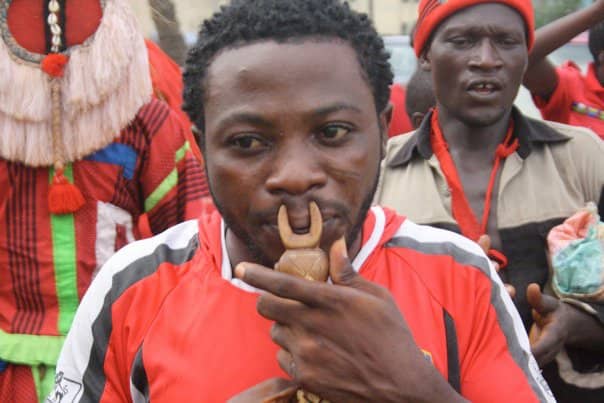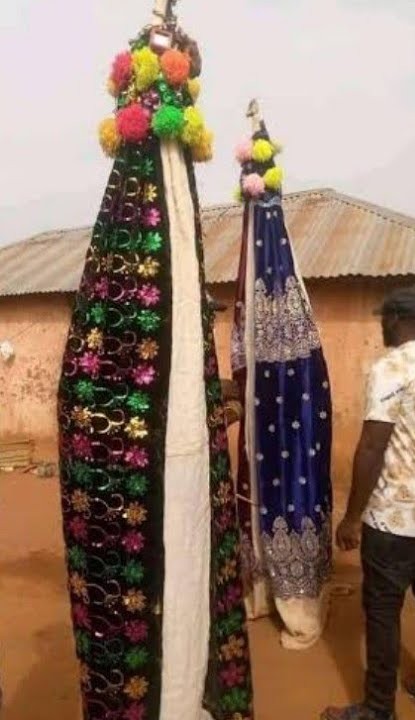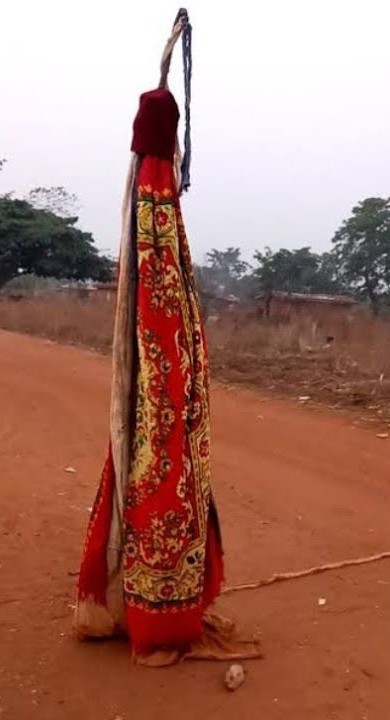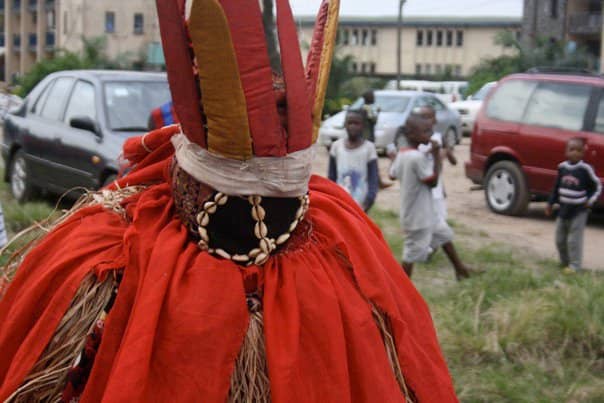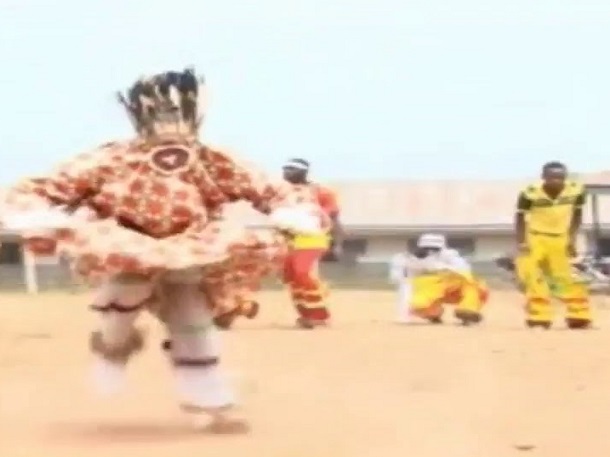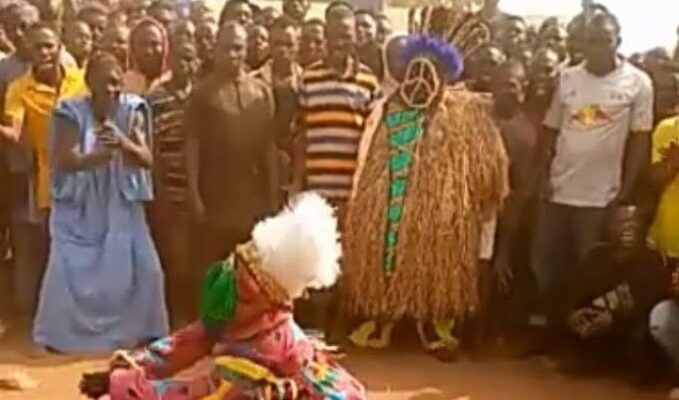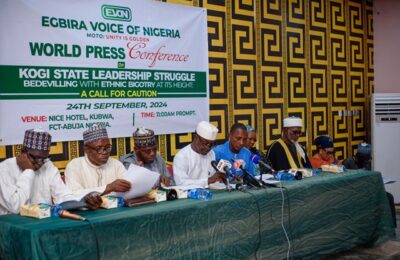By Abdul Aji and Aminudeen Ibrahim Ochika.
I feel excited and encouraged when I saw a write-up on Igala burial ceremonies written by my brother, Aminudeen Ibrahim Ochika on Facebook. I do not know the origin of Ochika, but am suspecting, from his writings, that he must have originated from Abocho area in Dekina Local Government Area. I am from Ofu Local Government Area. I am sure there are little diversities in the burial rites, as we try to point out. This will really make a good reading. The embrace of Islam and Christian religions has changed burial rites in Igala land. To this extent our upcoming children don’t understand or even know Igala has a traditional burial steps.
As related above, before the introduction of Islamic and Christian religions into Igala land, Igala people had their traditional ways of worship. According to their culture and customs, Igala people have their ways of burial when any one joins the ancestors.
The popular Igala traditional burial rites takes six steps for some families and clans while other families and clans take five or four steps.
Egwu-Eji is the first burial step, when any Igala man or woman passes on. If the deceased person is a young man or woman, he/she would be buried that same day, but elderly persons’ burial always takes place two or three days later. Today, dead people are kept in mortuary for days, weeks or months by Christians in Igala land.
Immediately after someone is dead the elders would gather and a distant relative would be appointed to take charge of the burial before any action is taken on any dead person. All burial contributions are handled by the appointed person who cannot dare spend a kobo personally from the fund. In some clans, such person buries the dead in his own place, if he doesn’t live far from location of the dead person.

Announcing death takes no special procedure in Igala land but in some clans, when an elderly or very important man or woman dies in the afternoon the elders will keep the news secrete till night, after dinner, before announcing officially; though some people would notice, as a result of some people’s mood.
After dinner, the death would be announced by gunshots and this announcement is known as akwu-eka. The burial will take place the following day or third day. Igala traditional burials is mostly never set beyond three days. If there is anything that makes the burial date to be set beyond three days, the dead person must be in the grave and covered half way – edu-kpeka. There were no mortuaries other than that. Note that the dead body would never be brought out again as the ceremony lasted. It is only Ogugu people of Olamaboro that would go and exhume the body if their relative, if buried in the wrong place, no matter the burial time, especially their female relatives.
A man may be buried in his residence while a woman may be taken to her home town for burial, depending on the decision of the relatives or the wish of the deceased.
After the death has been announced, there would be musical wake-keep display such as Iye-Oye as known all over Igala land, except Idah, Ajaka and Ugwolawo side of Igala Land that call this Obele. The Iye-Oye or Obele would be performed mainly by women till dawn. Ibele, folk-tale song, would also be sang at the inner compound, Anukwu, among elderly men till midnight. This would continue till burial day. Note the deference between Obele and Ibele.
At time of the burial, relatives and well-wishers from far and near would gather. They don’t come empty-handed, as some come with food items, pots and plates even as monetary contributions would be made at burial venue by all relatives, according to lineage. Igala people don’t leave burial expenses for the deceased’s immediate family to bear alone – everybody contributes to the burial fund. Igala believes that the dead person belongs the entire clan, not the immediate family.
Iya-Oye by women and Iya-Ogwu, war dance, by men would commence in the morning on the day of burial till when the burial proper kick-starts in the afternoon or evening. The burial would be declared opened by gunshot, then the corpse-semblance, abahi, would be brought out in Okpe, sackcloth. Before now, white cloth was not known in burial rites among Igala people; the used only sackcloths.
We call it corpse-semblance because, traditionally, Igala people don’t display the corpse in the open for everybody to see before burial. When an elderly person is dead, his body would be cleansed, dressed with Okpe, sackcloth, supplied by himself or his immediate family and put in the grave at the anukwu, compound. The grave would be covered with blank, tray or leaves pending the burial ceremony date and time. This is called edu-kpeka, that is, kept awaiting burial.
The corpse-semblance, an empty folded sackcloth, would be laid on a mat, the senior masquerade in the community called Egwu Olagenyi or Egwu Ada or Egwu Ogijo as known in some areas would be seated to supervise the exercise. If the deceased is from Egwu Afia family/clan, Egwu Afia masquerade would come and perform its rites. The children, grandchildren, in-laws and relatives would make burial of the deceased by presenting Okpe, sackcloth, with some tokens as custom demands. The son in-laws are expected present Okpe and monetary tokens which must be accepted by their wives whose father has died, same way daughters-in-law before it is handed over to the person earlier appointed to conduct the burial rites.
The lead masquerade present or talking unseen masquerades such as olowu, egwu-afia or ochimete, would lead in departure-song as four of the age mates of the deceased would come out to match round the corpse-semblance, abahi, with half papaya fruit, echibakpa, in hand. The half echibakpa serves as their third leg as they move round the abahi, ensuring they don’t go near each other, for it is a taboo for their body to touch. Out of the nine departure songs, the masquerade would lead in singing five songs while the four age mates would lead one song each.
After singing nine songs round the corpse-semblance the four age mates run to different directions to throw away the papaya fruit in their hands and they remain there until someone brings them water to clean their hands. They are not expected to follow each other to one direction – each person to his or her own direction.
After which the children of the deceased would produce a male fowl, aiko-eko, cock that crows, which would be slaughtered by sudden beheading of the cock on a sharp bow, cutlass or gun. This process is called ogwu-eda. This sacrifice is done to avoid sudden deaths among the immediate family of the deceased, after his departure. After all the sacrifices are done, the corpse-semblance would be carried to alu-oji, grave. At the grave side the corpse-semblance would be handed over to a man that would bury the corpse.
In the olden days, every community had a man who handles this duty. He is known as Omelegbe. Omelegbe is a person whose olfactory organ is not functioning, thus he cannot feel smells.
Some sacrifice would be performed at the grave side, where a she-goat would be sacrificed; this sacrifice is called ewo-ukpanyebie or utowo-nyebie. After joining the corpse-semblance with the dead body already laid in the grave before this time by Omelegbe, the Omelegbe would recite some incantations and then come out of the grave before the grave diggers fill up the grave with sand after removing earlier objects of preservation.
Traditionally, in some communities, the task of digging grave is the responsibility of son in-laws. The son in-laws are also responsible to cover the grave as well. The son in-laws, by this task are expected to entertain or give monetary rewards to the grave diggers. It is not to say they are compelled to dig grave by themselves. Several communities in Igala land do not put such task on son in-laws.
The grave top soil would be leveled down on the third day after which achekwu, hut, would be built on the burial point, may be at a later date. However, the achekwu is mostly built immediately.
Ebie, second burial is a minor burial rite always done on the 7th day after burial. A she-goat is used as sacrifice as members of the community and relatives come for this ceremony. However, whoever has a hand in the death of the deceased, spiritually, diabolically or physically is not expected to come near any of the burial rites. As a man, another man who has slept with the same woman with him is not also expected to attend the burial ceremonies.
The third burial is Egwele. This takes place 14 days after the burial. A she-goat is also used for sacrifice. The family may invite a musician to perform on this day or minor Ogba dance, known as Ogba egwele, would be displayed with just one or two masquerades. Some communities called this oji-elie, leveling of the grave. Every relative would depart after this rite.
The forth burial, ubi, which happens to be the greatest ceremony in most clans can wait for one or several years, depending on how the family want to prepare. In some clans, when it exceeds three years, the deceased would be alleged to be disturbing the family to perform his/her ubi, because the deceased is said to have not settled well among the dead without the ubi ceremony. In some communities ubi, indeed, is the final and most expensive burial ceremony.
When the family is fully prepared, they would announce the date for ubi which is always announced not less than three weeks to the event. The public announcement of Ubi is by gun shot at the grave yard. Once anyone in the community hears of such gun shot, it would be said that ubi has been announced and they would find out whose ubi is coming up.
In several clans ubi is always jointly done. Families with deceased persons who have not done the ubi of their persons would come together in a community and set convenient date. The ubi of over ten persons can be done together. At Igaojo Ame-onojo near Ojodu, in Ofu Local Government Area, ubi is not commonly done. It is done about once in twenty or more years. At that ancient village occupied by descendants of Akwumabi, they perform the ubi of over fifty persons at ago with just only one cow. Ram which is used in other clans to perform ubi is a taboo to them.
From the day ubi has been announced, Iye-Oye, Obele or Ogba dance would be performed every evening, briefly, till the set date. Ibele, folk-story song, would also be going on in the inner compound, Anukwu, among the elderly men.
On the day of Ubi, the Okpe or Abahi, that is the corpse-resemblance, would be laid on a mat. The abahi represent the deceased. The Olagenyi of the community would seat beside Abahi. Elders would coordinate the ceremony as the deceased’s children, grandchildren and in-laws would present Okpe again as done during first burial. If the deceased has many children and grandchildren, musicians or masquerades in performance would be many too as every child is expected to invite his or her own musician or masquerade. Where they cannot afford, they are allowed to join hands to bring their performer. After Egwu Olagenyi or Egwu Afia are done with their own rites, both of them would return to the land beyond. Ubi dance proper would commence in full force in the evening with massive Ogba dance till day break in some clans. Masquerades would be in fierce competition. The best masquerade always goes home with uloko red/black feather.
The following day, different types of musical displays would continue in the afternoon. Sacrifice would be going on at the grave side including ogwu-eda with matured cock, aiyiko eko, as done during the first burial. Rams would be skinned alive and cut into pieces without slaughtering by a selected relative who is without blemish. The ram is not expected to cry, if it does, the ceremony has gone bad and something disaster may happen after the ubi ceremony, which may include death of a close relative of the deceased.
The virgins among the grandchildren would be selected from both male and female to match round abahi, go round the compound and then return to sit with elders around the abahi. This activity is called ola-aju-egwe. In the olden days when horses were very much in use, they carried them on horses but now they use bicycles or motorcycles to carry them. The grandchildren would wear agbada and traditional cap known as Otajiya Ochachi. The women would accompany them round in large number with songs and dances.
The children, grandchildren, in-laws and relatives’ invited musicians that perform during the day time. They also invite masquerades. The sets of masquerades invited always come towards sun-set and all go to Abahi and greet Abahi and announce to the elders of their presence for Ubi. The masquerades such as Egwu Igba, Egwu Otito or Agbaka, Agbogo, Ogbanakwu, Egwu Ichekpa and Ajadu are always for Ubi.
The most popular masquerades for Ubi is Otito or Agbaka groups from Odu Ofomu, Agbaka group from Oje and Agbaka group from Inye, Acharane, as well as Agbaka group of late Yakubu Onweke Ejule.
The Ife clans do not use masquerades for Ubi; Iya-Ogwu is what they use for their Ubi.
The fifth burial –Ogba. Ogba and Ubi goes together. While some communities perform Ogba dance in the night before ubi day, others perform Ogba after Ubi day. As mentioned earlier, Ubi or Ogba is the final burial of anybody in Igala land, except males of Egwu-Afia Clan.
Some family or community leave their Ogba till further notice or do it during Ote-Ibegwu of their community.
On the day of Ogba, the elders gather together at the compound, the senior masquerade of that community known as Olagenyi would be the first masquerade to arrive and seat with the elders, all children would come with their masquerade they invited for Ogba and go straight to Anukwu for the introduction, Egwu Edu Gwugwa.
During the day time, there would be several musical displays but the night is meant for masquerades alone. The masquerades normally approved for ogba by Olagenyi are Owuna, Ajadu, Omabe etc but any masquerade that has human face like apoke are not accepted. There would always be Ibele in the evening before main Ogba commences with masquerades.
As earlier mentioned, they danced till day break. Ogba dancing is separated into two sections; ogba or Igede and Edu.
As mentioned above, at dawn, ram would be sacrificed at the grave yard. This activity is called EKOJETA. This brings Ogba to an end. Ogba is the final burial for females and males in some family/clan except males from Egwu-Afia clan.
Sixth burial, Egwu-Ekodufu for male of Egwu-Afia clan is the greatest burial in this clan as the man who died some years back is coming back to this world again to live with the family as masquerade known as Egwu-Afia. This event can take place at any time the family is prepared. Most time ten to twenty families whose father died previously come together to return their fathers in Egwu-Afia. When a date is agreed by the members of the family, it would be officially announced to relatives.
The event takes place for about three months. It starts with a visit by a different Egwu-Afia to the children of the deceased, on behalf of the deceased. This activity is known as Egwu-Egbabo.
If, for instance, a child of deceased lives at Idah and the event is taking place at Iyale, the masquerade for bringing out deceased has to go to Idah and visit the child’s compound.
The next rite is the day of Otacho, this is the day chief priest, Ode, would go to the shrine, Okwula.
After this day, comes night ceremonial events known as Ogba Ogidigidi. This Ogba is performed by Egwu-Afia alone. No female is allowed to watch this Ogba. Men below 45years old are not allowed as well.
The fourth day is the main day and this is the day an old egwu-afia masquerade would search for the deceased. The deceased would be found in the night and then brought to Otacho. The old masquerade would then announce the founding of the new Egwu-Afia, very early in the following morning. The family members and relatives would be excited to go and see their father that has been found lying on the Otacho.
At sunrise the new masquerade would rise and go to Okula with other newly founded masquerade. They would stay in Okula for three days as different sacrifices would be done within these days.
On the third day before sunset the new masquerade would be escorted by old Egwu Afia to their various destinations. It is the old masquerade that would be talking throughout the journey.
The family members and the relatives would all accompany the masquerade to the family house of the new masquerade. The family members would all welcome the Egwu Afia to his house by pouring water on the ground and he matched on. As new masquerade would not talk for three months when Ochuketa would be done, the old masquerade that escorts him would talk to family members and deliver messages from new Egwu-Afia.
Three months later, Ochukete would be done and the new Egwu-Afia starts to talk. The new Egwu-Afia would then be coming out yearly during Ote-Ibegwu and also come out anytime there is crisis in his compound to settle the matter among his children and daughter in-laws.
